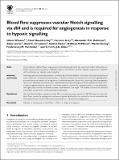Files in this item
Blood flow suppresses vascular Notch signalling via dll4 and is required for angiogenesis in response to hypoxic signalling
Item metadata
| dc.contributor.author | Watson, Oliver | |
| dc.contributor.author | Novodvorsky, Peter | |
| dc.contributor.author | Gray, Caroline | |
| dc.contributor.author | Rothman, Alexander M. K. | |
| dc.contributor.author | Lawrie, Allan | |
| dc.contributor.author | Crossman, David C. | |
| dc.contributor.author | Haase, Andrea | |
| dc.contributor.author | McMahon, Kathryn | |
| dc.contributor.author | Gering, Martin | |
| dc.contributor.author | Van Eeden, Fredericus J. M. | |
| dc.contributor.author | Chico, Timothy J. A. | |
| dc.date.accessioned | 2015-08-07T15:40:03Z | |
| dc.date.available | 2015-08-07T15:40:03Z | |
| dc.date.issued | 2013-11-01 | |
| dc.identifier | 207746795 | |
| dc.identifier | f3e4af2a-a4cc-43f6-8680-2257ec406e46 | |
| dc.identifier | 000326015200011 | |
| dc.identifier | 84885967027 | |
| dc.identifier.citation | Watson , O , Novodvorsky , P , Gray , C , Rothman , A M K , Lawrie , A , Crossman , D C , Haase , A , McMahon , K , Gering , M , Van Eeden , F J M & Chico , T J A 2013 , ' Blood flow suppresses vascular Notch signalling via dll4 and is required for angiogenesis in response to hypoxic signalling ' , Cardiovascular Research , vol. 100 , no. 2 , pp. 252-261 . https://doi.org/10.1093/cvr/cvt170 | en |
| dc.identifier.issn | 0008-6363 | |
| dc.identifier.other | ORCID: /0000-0003-4762-8623/work/60196623 | |
| dc.identifier.uri | https://hdl.handle.net/10023/7155 | |
| dc.description | This work was supported by BHF project grants (09/287/28051 and 12/12/ 29433) awarded to T.J.A.C. F.J.M.E. was supported by EC-FP7 HEALTHF4-2010-242048. MRC Centre Grant (G0700091) awarded to Professor PW Ingham provided a clinical training fellowship to OJW. Funding for Open Access was provided by he research was funded by the British Heart Foundation. | en |
| dc.description.abstract | The contribution of blood flow to angiogenesis is incompletely understood. We examined the effect of blood flow on Notch signalling in the vasculature of zebrafish embryos, and whether blood flow regulates angiogenesis in zebrafish with constitutively up-regulated hypoxic signalling. Developing zebrafish (Danio rerio) embryos survive via diffusion in the absence of circulation induced by knockdown of cardiac troponin T2 or chemical cardiac cessation. The absence of blood flow increased vascular Notch signalling in 48 h post-fertilization old embryos via up-regulation of the Notch ligand dll4. Despite this, patterning of the intersegmental vessels is not affected by absent blood flow. We therefore examined homozygous vhl mutant zebrafish that have constitutively up-regulated hypoxic signalling. These display excessive and aberrant angiogenesis from 72 h post-fertilization, with significantly increased endothelial number, vessel diameter, and length. The absence of blood flow abolished these effects, though normal vessel patterning was preserved. We show that blood flow suppresses vascular Notch signalling via down-regulation of dll4. We have also shown that blood flow is required for angiogenesis in response to hypoxic signalling but is not required for normal vessel patterning. These data indicate important differences in hypoxia-driven vs. developmental angiogenesis. | |
| dc.format.extent | 10 | |
| dc.format.extent | 1458394 | |
| dc.language.iso | eng | |
| dc.relation.ispartof | Cardiovascular Research | en |
| dc.subject | Zebrafish | en |
| dc.subject | Angiogenesis | en |
| dc.subject | Blood flow | en |
| dc.subject | Notch | en |
| dc.subject | Angio-/arteriogenesis | en |
| dc.subject | R Medicine | en |
| dc.subject.lcc | R | en |
| dc.title | Blood flow suppresses vascular Notch signalling via dll4 and is required for angiogenesis in response to hypoxic signalling | en |
| dc.type | Journal article | en |
| dc.contributor.institution | University of St Andrews. School of Medicine | en |
| dc.contributor.institution | University of St Andrews. Office of the Principal | en |
| dc.identifier.doi | https://doi.org/10.1093/cvr/cvt170 | |
| dc.description.status | Peer reviewed | en |
This item appears in the following Collection(s)
Items in the St Andrews Research Repository are protected by copyright, with all rights reserved, unless otherwise indicated.

